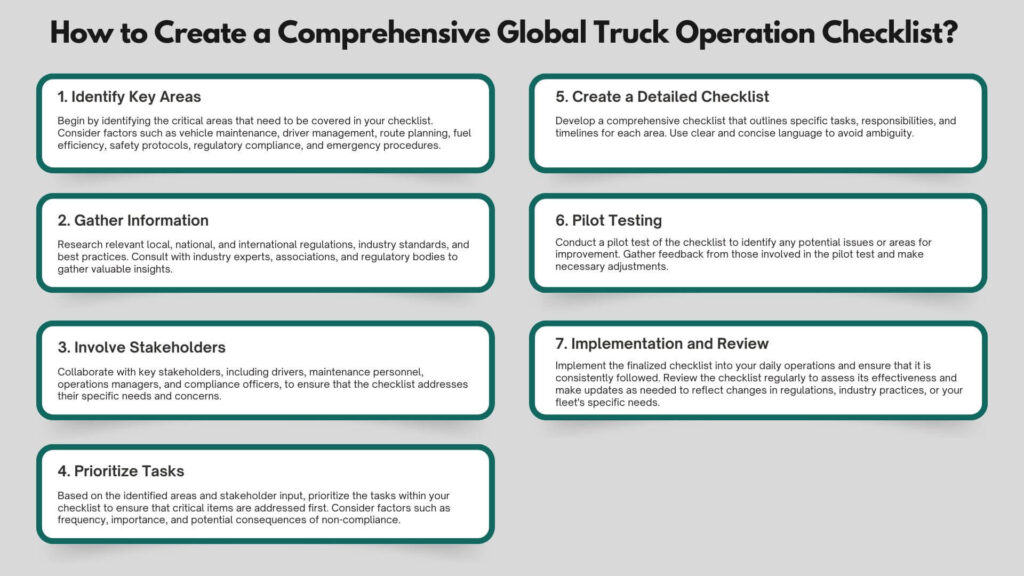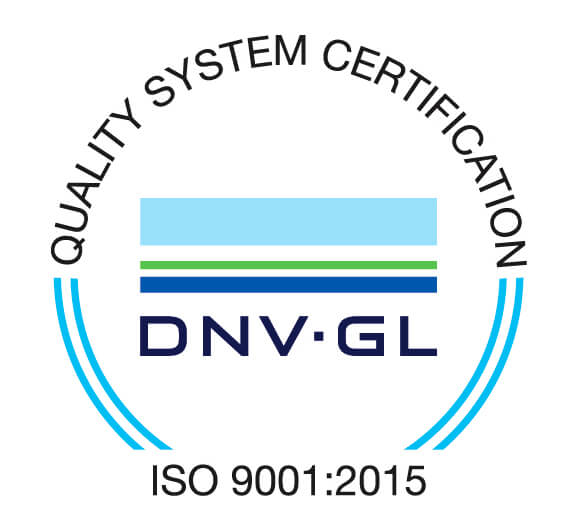Ensuring that your global fleet of trucks is running at peak performance and efficiency is essential to the success and profitability of any business. To do so, you need a global truck operation checklist (GTO) that covers all aspects of the trucking industry.
From maintenance schedules and safety protocols to fuel efficiency and up-to-date driver regulations, these checklists provide businesses with a comprehensive guide to operating their fleets while maximizing profits. This article will discuss why having a GTO is essential and how you can create one for your organization.
Table of Contents
ToggleWhat is a Global Truck Operation Checklist?

A global truck operation checklist (GTO) is a document that contains all the necessary information for global transportation companies to ensure that their fleets remain in top condition. The GTO outlines maintenance schedules, safety protocols, fuel efficiency, and up-to-date driver regulations. It also provides guidance on creating a comprehensive checklist covering all areas of a trucking business.
By having a GTO, global transportation companies can maximize their profits while ensuring their fleets remain well-maintained and safe. Additionally, having a GTO ensures that global transportation companies are in compliance with government regulations and industry standards.
Who Benefits from a Global Truck Operation Checklist?
A global truck operation checklist is a valuable tool for any organization involved in global transportation, regardless of its size or scale. From small businesses with a handful of trucks to multinational corporations managing extensive fleets, a well-structured checklist can significantly enhance operational efficiency, ensure regulatory compliance, and mitigate risks.
The following are some notable Benefits of a GTO checklist for Global Transportation Companies:
- Improved Operational Efficiency: A checklist helps streamline processes, reduce downtime, and optimize resource allocation, leading to increased productivity.
- Enhanced Regulatory Compliance: By identifying and addressing potential non-compliance issues, a checklist helps businesses avoid costly fines and penalties.
- Mitigated Risk: A checklist can identify and address potential safety hazards, reducing the risk of accidents and ensuring the well-being of drivers and cargo.
- Cost Savings: By optimizing operations and minimizing downtime, a checklist can contribute to significant cost savings.
- Improved Customer Satisfaction: A well-managed fleet can deliver goods and services more reliably, leading to higher customer satisfaction.
Essential Components of a Global Truck Operation Checklist

A comprehensive global truck operation checklist should encompass a wide range of factors to ensure efficient, safe, and compliant operations. The following sections outline key areas to consider:
Maintenance and Vehicle Care
- Regular Maintenance Schedules: Establish a detailed maintenance schedule for each truck, including intervals for oil changes, tire rotations, brake inspections, and other essential checks.
- Preventive Maintenance: Implement a proactive maintenance approach to identify and address potential issues before they escalate into costly breakdowns.
- Driver Involvement: Educate drivers on the importance of routine maintenance and empower them to report any unusual noises, vibrations, or warning lights.
Safety and Driver Training
- Comprehensive Safety Training: Provide thorough safety training to all drivers, covering topics such as defensive driving techniques, emergency procedures, load securement, and hazard identification.
- Safety Protocols: Establish clear safety protocols and guidelines, including seatbelt usage, speed limits, and adherence to local traffic laws.
- Regular Safety Reviews: Conduct periodic safety reviews to assess driver performance, identify areas for improvement, and reinforce safety best practices.
Fuel Efficiency and Environmental Responsibility
- Fuel Efficiency Training: Educate drivers on fuel-efficient driving techniques, such as maintaining steady speeds, avoiding excessive idling, and planning routes to minimize fuel consumption.
- Vehicle Optimization: Regularly evaluate the fuel efficiency of your fleet and explore opportunities for optimization, such as upgrading to more efficient models or implementing telematics systems.
- Environmental Compliance: Ensure compliance with local and international environmental regulations related to emissions, fuel quality, and waste management.
Driver Regulations and Compliance
- Regulatory Awareness: Inform drivers about relevant local, national, and international regulations regarding driving hours, licensing requirements, and safety standards.
- License Verification: Regularly verify the validity of driver’s licenses and ensure that all required certifications are up-to-date.
- Compliance Audits: Conduct periodic compliance audits to identify and address any non-compliance issues.
Licensing and Insurance
- Insurance Coverage: Ensure that all trucks are adequately insured with appropriate coverage for liability, property damage, and cargo theft.
- License Verification: Verify that all trucks are registered and licensed in accordance with local and national regulations.
- Safety Standards: Ensure that all trucks meet the necessary safety standards and undergo regular inspections.
How to Create a Comprehensive Global Truck Operation Checklist?
Creating a tailored global truck operation checklist requires a systematic approach to ensure it effectively addresses your specific needs and meets regulatory requirements. Here’s a step-by-step walkthrough:

- Identify Key Areas: Begin by identifying the critical areas that need to be covered in your checklist. Consider factors such as vehicle maintenance, driver management, route planning, fuel efficiency, safety protocols, regulatory compliance, and emergency procedures.
- Gather Information: Research relevant local, national, and international regulations, industry standards, and best practices. Consult with industry experts, associations, and regulatory bodies to gather valuable insights.
- Involve Stakeholders: Collaborate with key stakeholders, including drivers, maintenance personnel, operations managers, and compliance officers, to ensure that the checklist addresses their specific needs and concerns.
- Prioritize Tasks: Based on the identified areas and stakeholder input, prioritize the tasks within your checklist to ensure that critical items are addressed first. Consider factors such as frequency, importance, and potential consequences of non-compliance.
- Create a Detailed Checklist: Develop a comprehensive checklist that outlines specific tasks, responsibilities, and timelines for each area. Use clear and concise language to avoid ambiguity.
- Pilot Testing: Conduct a pilot test of the checklist to identify any potential issues or areas for improvement. Gather feedback from those involved in the pilot test and make necessary adjustments.
- Implementation and Review: Implement the finalized checklist into your daily operations and ensure that it is consistently followed. Review the checklist regularly to assess its effectiveness and make updates as needed to reflect changes in regulations, industry practices, or your fleet’s specific needs.
By following these steps, you can create a global truck operation checklist that is tailored to your organization, ensures compliance, and optimizes your fleet’s performance.
Frequently Asked Questions (FAQs)
Q1: How often should a global truck operation checklist be updated?
A global truck operation checklist should be reviewed and updated regularly, at least annually, to ensure it remains aligned with evolving regulations, industry best practices, and your organization’s specific needs. Significant changes in your fleet, operations, or the regulatory landscape may need more frequent updates.
Q2: What are the potential consequences of not having a global truck operation checklist in place?
Failure to implement a comprehensive global truck operation checklist can lead to a variety of negative consequences, including:
- Increased risk of accidents and injuries
- Non-compliance with local, national, and international regulations
- Increased maintenance costs and downtime
- Reduced operational efficiency
- Damage to your organization’s reputation
Q3: How can a global truck operation checklist help improve driver safety?
A well-designed global truck operation checklist can significantly enhance driver safety by:
- Ensuring that vehicles are properly maintained and inspected
- Providing drivers with clear safety guidelines and procedures
- Encouraging regular safety training and education
- Identifying and addressing potential safety hazards before they lead to accidents
Q4: What are some common challenges in implementing a global truck operation checklist?
Some common challenges in implementing a global truck operation checklist include:
- Resistance to change from employees
- Lack of resources or support
- Difficulty in ensuring consistent compliance across different locations
- Keeping up with evolving regulations and industry standards
Q5: How can technology be used to support global truck operation checklists?
Technology can play a crucial role in supporting global truck operation checklists by:
- Providing automated reminders and notifications for maintenance tasks
- Tracking vehicle performance and identifying potential issues
- Facilitating electronic documentation and record-keeping
- Enabling remote monitoring and management of fleets
Q6: How can a global truck operation checklist contribute to sustainable practices?
A well-designed global truck operation checklist can help promote sustainable practices by:
- Encouraging fuel-efficient driving and vehicle maintenance
- Reducing emissions and environmental impact
- Ensuring compliance with environmental regulations
- Promoting responsible waste management and recycling
Conclusion
A well-structured global truck operation checklist is an indispensable tool for businesses operating fleets across international borders. By providing a comprehensive framework for managing maintenance, safety, compliance, and efficiency, a checklist can significantly enhance operational performance, mitigate risks, and ensure the long-term sustainability of your global trucking enterprise.
The goal of this article was to provide a clear understanding of the importance of global truck operation checklists, their key components, and the steps involved in creating an effective checklist. By following the guidelines outlined in this article, you can develop a tailored checklist that meets your specific needs and helps your fleet operate at its optimal level.
We encourage readers to take the following steps:
- Assess your current practices: Evaluate your existing procedures and identify areas where a global truck operation checklist could improve efficiency and compliance.
- Develop a tailored checklist: Use the information provided in this article as a starting point to create a comprehensive checklist that addresses your specific needs and regulatory requirements.
- Implement and review: Implement your checklist into your daily operations and regularly review it to ensure it remains effective and up-to-date.
By investing time and effort into creating and implementing a global truck operation checklist, you can significantly enhance the performance, safety, and sustainability of your global fleet.
Create Global Truck Operation Checklists with DATAMYTE
DATAMYTE is a quality management platform with low-code capabilities. Our Digital Clipboard, in particular, is a low-code workflow automation software that features a workflow, checklist, and smart form builder. This tool lets you easily create, deploy, and manage standardized Global Truck Operation Checklists, ensuring consistency and compliance across all your operations, regardless of location.
DATAMYTE also lets you conduct layered process audits (LPA), a high-frequency evaluation of critical process steps, focusing on areas with the highest failure risk or non-compliance. Conducting LPA with DATAMYTE lets you effectively identify and correct potential defects before they become major quality issues.
With DATAMYTE, you have an all-in-one solution for efficiently managing and optimizing truck operation checklists on a global scale. Book a demo now to learn more.



